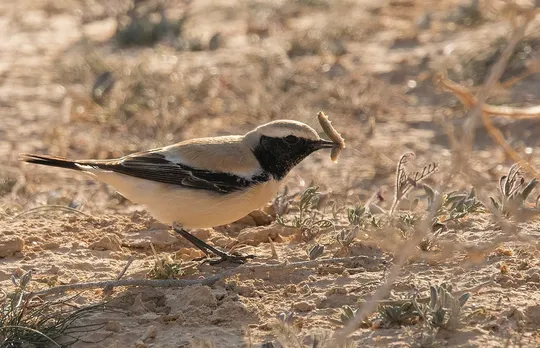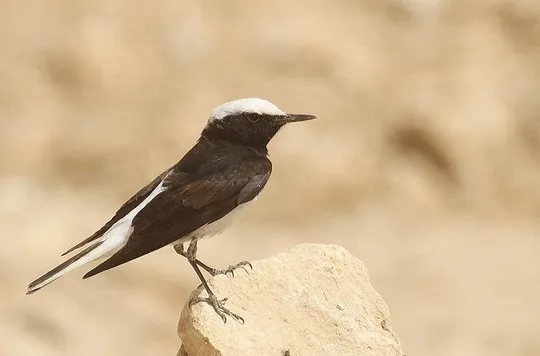Oenanthe hispanica
 Endangered
Endangered
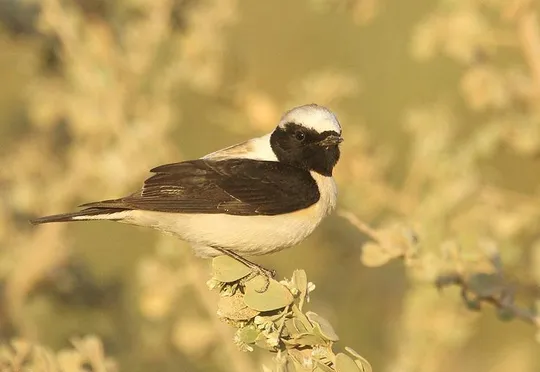
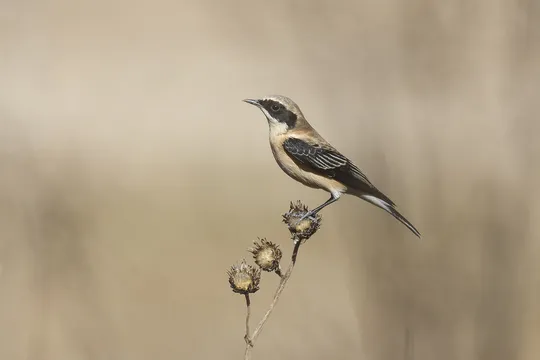

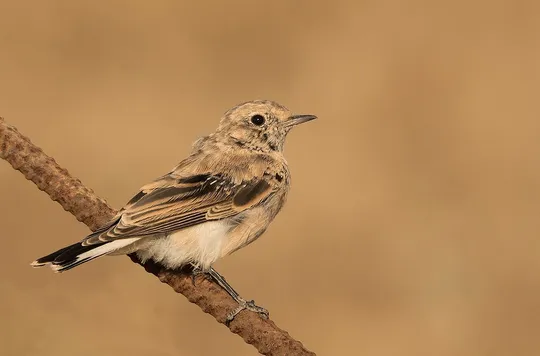
| Habitats | Rocky Terrain, Mediterranean Batha, Semi-desert Batha |
|---|---|
| Presence In Israel | Summer, Migrant |
| Breeding In Israel | Breeder |
| Migration Types | Long Range |
| Zoographical Zones | Mediterranean, Irano-Turanian |
| Landscape Types | Mountainous, Rugged Terrain |
| Vegetation Types | Steppe |
| Vegetation Densities | Medium, Low |
| Nest Locations | Ground |
| Diet Types | Invertebrate |
| Foraging Grounds | Ground |
| Body Sizes | Small (up to 500g) |
| Threat Factors | Wildfires, Habitat destruction in migration and wintering areas, Habitat loss and fragmentation, Tree planting |
The Black-eared Wheatear is the only wheatear that summers and breeds in northern and central Israel (with the exception of the Mt. Hermon heights, where other wheatear species breed). It is conspicuous with its contrasting black-white plumage, territorial behavior and loud song. It is sexually dimorphic – the males have a very contrasting plumage with a white or yellowish crown, back and belly, contrasting with the black wings and cheeks; some of the individuals have black throats. The females are brown-gray with white only on their tails.
Inhabits rocky shrubland, often in cliff walls, at the edge of quarries and in areas undergoing development and soil stripping.
The Black-eared Wheatear is in continuous, gradual decline in Israel and in Eastern Europe for the past two decades. The decline is not uniform throughout its breeding range in Israel – in some areas it has completely disappeared, while in other areas, such as Eastern Samaria and the Mt. Hermon slopes there are still dense nesting areas.
The Black-eared Wheatear is threatened by development, destruction and modification of shrublands and their conversion to settlements and planted forests. In the Judean Lowlands, Eastern Lakhish and Western Samaria it has been impacted by frequent wildfires started by army training exercises. In addition, the species is also apparently affected by desertification processes and overexploitation in its wintering and migration areas.
No specific conservation measures have been taken for this species to date.
The Black-eared Wheatear is a migrating species classified as Endangered because of the decline in its population size and range. During the past two decades, it has disappeared from extensive areas in Western Samaria, the Carmel and the Galilee. The major factors threatening the species in Israel are the continued reduction of uninterrupted shrubland areas and their quality, and also desertification processes and overexploitation of habitats in the species’ wintering range and along its migration route.
Educational activities in army units to reduce wildfire incidents.
Expanding firebreaks to prevent fire expansion.
Restricting afforestation in shrublands.
Protecting continuous shrubland areas from construction and development.
- ישראלי, נ. ופרלמן, י. 2013. סיכום סקר עופות מקננים בחרמון. דו"ח מרכז הצפרות של החברה להגנת הטבע.
- מירוז, א. 2008. סיכום סקר ציפורים בשמורת סנסן אביב 2008. דו"ח רשות הטבע והגנים ומרכז הצפרות של החברה להגנת הטבע.
- מירוז, א. 2013. סיכום סקר ציפורים במזרח לכיש, אביב 2013. דו"ח רשות הטבע והגנים.
- מירוז, א. ושוחט, א. 2014. סיכום סקר ציפורים סביב היישוב נטע במזרח לכיש – 2014. דו"ח רשות הטבע והגנים.
- מירוז, א., 2007 . סיכום סקר ציפורים בגבעות גומר. דו"ח עבור רשות הטבע והגנים.
- פז, ע. 1986. עופות. מתוך אלון, ע. (עורך), החי והצומח של ארץ ישראל. כרך 6. הוצאת משרד הביטחון, ישראל.
- Shirihai, H., 1996. The Birds of Israel. Academic Press, London.
- Shochat, E., Abramski, Z., Pinshow, B., 2001. Breeding bird species diversity in the Negev: Effects of Scrub Fragmentation by planted forests. Journal of Applied Ecology, 38, 1135-1147.
- Symes, A. 2013. Species generation lengths. Unpublished, BirdLife International.
- Species page at Birdlife International
Current Occupancy Map
| Data Missing | Sporadic | Limited Sites | Low Density | High Density |
|---|---|---|---|---|
| 0 | 0 | 0 | 0 | 0 |
Distribution maps
The maps presented here provide visual information on the distribution of species in Israel from the past and present, and the changes in occupancy and breeding density during the comparison period. For further reading
Relative Abundance 2010-2020
Breeding density values in the current decade as determined from experts' opinion and observations from databases.
| Data Missing | Sporadic | Limited Sites | Low Density | High Density |
|---|---|---|---|---|
| 8 | 12 | 12 | 21 | 19 |
Relative Abundance 1980-1990
Density values based primarily on the book The Birds of Israel (Shirihai 1996).
| Data Missing | Sporadic | Limited Sites | Low Density | High Density |
|---|---|---|---|---|
| 5 | 14 | 14 | 17 | 22 |
Occupancy 1990-2020
The map shows differences in the species breeding distribution between the 1980's breeding map and the current weighted breeding evaluation. Negative value - species previously bred in the grid and is not presently breeding; positive value - species has not previously bred in the grid and is currently breeding.
| Data Missing | No Change | Occupancy Increase | Occupancy Decrease |
|---|---|---|---|
| 6 | 35 | 1 | 9 |
Change in Relative Abundance 1990-2020
The map shows the changes in the relative abundance of a species in each of the distribution grids between the breeding map of the 1980s and the weighted current breeding evaluation. Negative values - decline in abundance; positive values - increase in abundance; zero - no change in abundance.
| 80 to 100 | 50 | 20 to 30 | No Change | 30- to 20- | 50- | 100- to 80- | Data Missing |
|---|---|---|---|---|---|---|---|
| 0 | 4 | 2 | 22 | 12 | 14 | 11 | 16 |
| Rarity | |
|---|---|
| Vulnerability | |
| Attractiveness | |
| Endemism | |
| Red number | |
| Peripherality | |
| IUCN category | |
| Threat Definition according to the red book |
 Contributed:
Contributed: 
